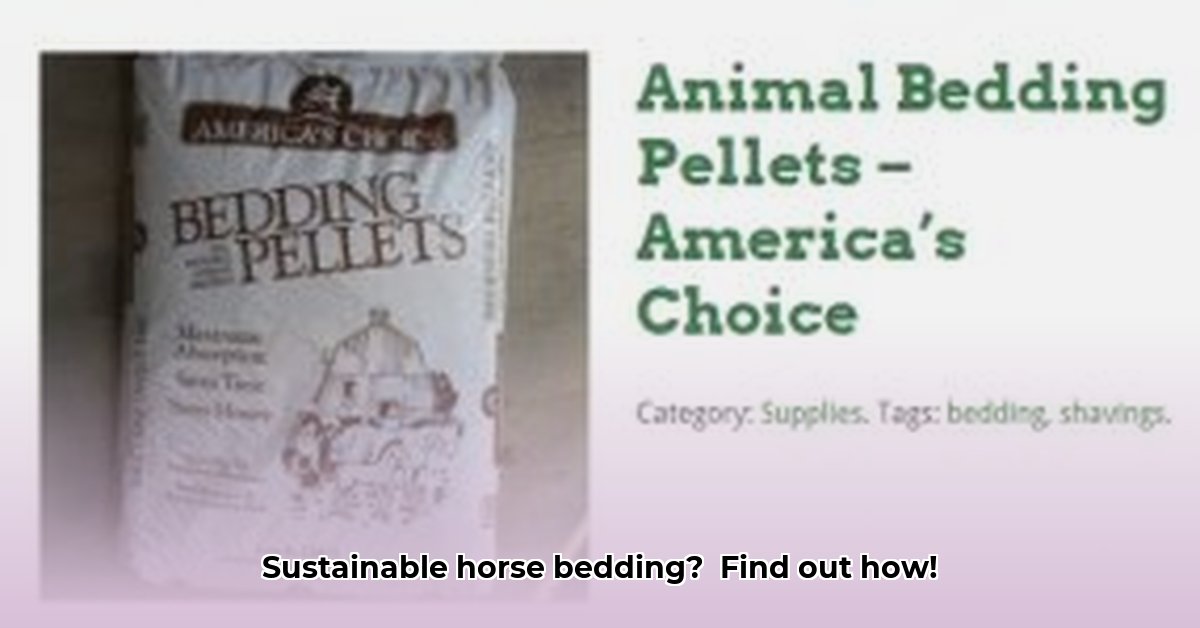
Corn Cob Bedding: A Sustainable Alternative
Are you concerned about the environmental impact of your horse's bedding? Many horse owners are seeking greener alternatives to traditional wood shavings. Corn cob bedding, readily available at Tractor Supply and other retailers, presents a compelling option. This article compares corn cob and wood shavings bedding, examining sustainability, cost-effectiveness, and practical considerations to help you make an informed decision. For more information on retailers, check out Tractor Supply locations.
Advantages of Corn Cob Bedding
Traditional wood shavings contribute to deforestation and require substantial transportation, resulting in a significant carbon footprint. Corn cob bedding offers a more sustainable solution. It utilizes a renewable resource—corn—reducing the environmental impact. Furthermore, corn cobs compost significantly faster than wood shavings; some studies suggest a composting time of as little as six months. This rapid decomposition translates to less landfill waste and quicker nutrient-rich compost for your land.
Advantages:
- Rapid Composting: Significantly reduces landfill waste and provides nutrient-rich compost faster than wood shavings.
- Biodegradability: Naturally breaks down completely, leaving no harmful residues.
- Sustainable Source: Made from a renewable resource, minimizing reliance on deforestation.
- Potential Cost Savings: While initial costs may be similar, faster decomposition could lead to long-term savings (further research is needed to confirm this definitively for all situations).
Potential Drawbacks of Corn Cob Bedding
Despite its benefits, corn cob bedding has potential downsides. Some horses may find corn cobs palatable, leading to potential digestive issues. A gradual transition and close monitoring of your horse's behavior are crucial. The scent may also differ from wood shavings, but horses typically adapt well to new bedding. Finally, a comprehensive cost analysis comparing corn cob and wood shavings bedding over time requires further investigation.
Wood Shaving Bedding: The Traditional Approach
Wood shavings remain a widely used bedding material due to their familiarity and accessibility. However, their environmental impact is increasingly a concern. The harvesting and transportation of wood contribute to deforestation and greenhouse gas emissions.
Advantages of Wood Shaving Bedding
Wood shavings have long been the preferred bedding choice thanks to their widespread availability and ease of use. They are generally well-accepted by horses and readily accessible at most feed stores.
Disadvantages of Wood Shaving Bedding
The environmental impact of wood shavings is substantial. Deforestation and transportation significantly contribute to greenhouse gas emissions. Furthermore, wood shavings’ slower decomposition rate leads to increased landfill waste.
Comparative Analysis: Corn Cob vs. Wood Shavings
Let's compare corn cob and wood shavings directly:
| Feature | Corn Cob Bedding | Wood Shavings |
|---|---|---|
| Composting Time | Substantially faster (potentially under 6 months) | Significantly slower (often months or years) |
| Environmental Impact | Lower, utilizes a renewable resource | Higher, contributes to deforestation and transportation emissions |
| Palatability | Potential for consumption, requires monitoring | Generally not consumed |
| Scent | Unique aroma, may require acclimation | Familiar, typically neutral scent |
| Availability | Increasingly available at Tractor Supply and other retailers | Widely available at most feed stores |
| Cost | Requires further investigation for definitive comparison | Established market price |
Actionable Advice for Horse Owners
Switching to corn cob bedding requires careful planning:
- Gradual Introduction: Mix a small amount of corn cob bedding with the existing bedding initially.
- Close Monitoring: Observe your horse closely for any behavioral changes or consumption of the bedding.
- Cost Tracking: Keep detailed records of bedding expenses to assess long-term cost-effectiveness.
- Local Sourcing: Explore bulk purchasing or local suppliers to potentially reduce costs and environmental impact.
- Long-Term Assessment: Evaluate the composting rate and overall sustainability of corn cob bedding within your farm's context.
Conclusion: A Sustainable Choice?
Corn cob bedding offers a promising sustainable alternative to wood shavings for horse stalls. Its rapid composting rate and renewable resource base significantly reduce environmental impact. However, potential palatability issues and uncertainties regarding the long-term cost-effectiveness warrant careful consideration. A gradual transition, close monitoring of your horse, and comprehensive cost analysis will help determine its suitability for your specific situation. The move towards sustainable agricultural practices is crucial, and corn cob bedding represents a step in the right direction, though further research is needed to fully optimize its use.